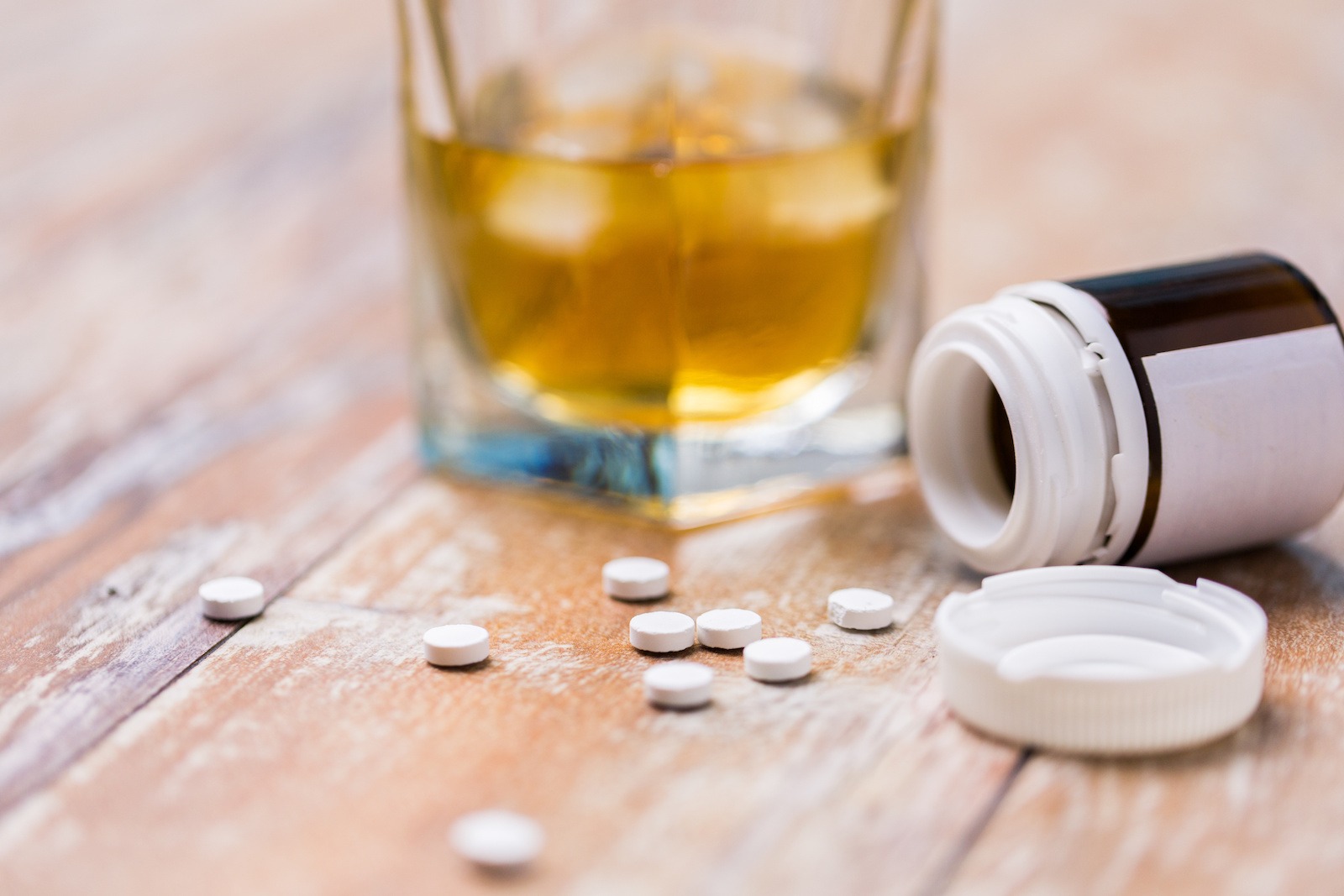Addiction | 6 min read
Xanax And Alcohol: Why It’s Essential To Know The Side-Effects & Dangers Of Mixing Drugs Before You Combine Them
Medically Reviewed By

On September 05, 2022
Written By
On September 5, 2022

When mixing drugs and alcohol, most people know it’s not a good idea. But, one of the problems is that when people think of drugs, they think of illicit and illegal drugs, but they don’t always consider that their prescriptions are drugs too. The only difference is that prescription drugs have a specific use, worth the potential side effects and risks of taking the drug.
That can lead to people taking potentially toxic drug combinations, like Xanax and alcohol. The problem worsens when you consider the casual approach many people have to using alcohol and how common alcohol is in our culture.
Xanax and alcohol are a potentially dangerous combination and shouldn’t be taken together. However, people sometimes take them together accidentally, and sometimes intentionally, which can be particularly hazardous.
Here’s what you need to know about mixing alcohol and Xanax, the side effects, and why these drugs can be fatally dangerous when taken together.
Xanax And Alcohol Side Effects
Xanax is the single most commonly prescribed psychiatric drug in the United States.[1] It’s a benzodiazepine and produces calming effects in users. It can help control various mental health symptoms, but is most commonly used to control anxiety.
Xanax works on your central nervous system for most of its effects, which is important because alcohol also affects your central nervous system. There are a lot of potential side effects from Xanax, including:[2]
- Drowsiness
- Lightheadedness
- Shallow breathing
- Hallucinations
- Increased energy
- Racing thoughts
- Agitation
- Double vision
- Jaundice
- Sudden mood changes
- Confusion
- Suicidal thoughts or actions
- Seizures
Most people don’t have severe side effects from Xanax and may only have one or two side effects from that list at the proper dose and when Xanax is taken responsibly.
Alcohol might be commonly accepted as a recreational drug, but it also comes with a variety of short and long-term effects:[3]
- Side effects from alcohol use include:
- Impaired judgment and coordination
- Slowed reaction time
- Confusion and memory lapses
- Headaches and dizziness
- Blurred vision and sensory distortion
- Euphoria
- Anxiety and depression
- Irritability
- Insomnia
- Nausea and vomiting
- Fatigue and weakness
- Weight changes
- Changes in blood pressure and heart rate
In addition to those side effects, alcohol use can increase your long-term risk of various conditions.[4] For instance, your cancer risk increases with alcohol, especially chronic use, binge drinking, or drinking too much in one sitting.
Alcohol use also puts a lot of strain on your liver and kidneys, which can cause problems with other drug use, even if it isn’t a direct problem with your alcohol use. Additionally, you are at higher risk of heart disease, strokes, and high blood pressure.
Can You Drink on Xanax?
While Xanax and alcohol are considered safe when used responsibly and in reasonable doses, these medications can have a variety of frightening and potentially fatal interactions when taken together.
One of the reasons that Xanax and alcohol are so dangerous when taken together is that they both work to calm or depress your central nervous system. That’s why these drugs produce calm, happy feelings in the people who use them. However, when your central nervous system is too depressed, many issues can be potentially fatal if they aren’t treated immediately.
There are two primary concerns when you mix Xanax and alcohol. The first is that taking the drugs together greatly increases the chances that you will overdose on one or both of them, leading to organ damage, serious side effects, and death.[5]
The other concern is that the two drugs may depress your central nervous system so much that you stop breathing.[6] If your condition isn’t noticed and treated within minutes, this side effect can also be fatal.
If you’re tempted to mix these drugs despite the dangers, that may be a strong indicator that you’re dealing with a benzodiazepine or alcohol addiction, that your mental health disorder is not being adequately managed, or that you are more likely to develop substance use disorders as a result.
Why People Mix Xanax and Alcohol
People may mix Xanax and alcohol without fully understanding the risks. Sometimes it’s accidental, like having a drink at dinner and taking a prescription dose later that night. However, sometimes the mix is intentional to enhance the calming or euphoric effects, especially in stressful social situations or to self-medicate anxiety and sleep problems.
The problem is that both substances are central nervous system depressants that slow down critical brain functions like heart rate, breathing, and coordination. While you may feel relaxed initially, the combination can quickly overwhelm the body’s system. The overlap in their sedative effects can increase the risk of blackouts, overdose, or respiratory failure.
How Long After Drinking Can You Take Xanax?
There’s no safe window for taking Xanax after drinking alcohol. The liver metabolizes alcohol at a rate of about one standard drink per hour, but factors like liver health, body weight, age, and how much alcohol you consume can affect this rate. Xanax has a half-life of approximately 11 hours, meaning it remains in your system for a significantly longer period.[7]
It’s best to wait at least 24 hours after moderate drinking before taking your medication to minimize the risk of dangerous Xanax and alcohol interactions. If you engaged in heavy drinking or binge drinking, you may need to wait longer. Always talk to your doctor about when it’s safe to drink after taking Xanax.
What to Do If You’ve Mixed Alcohol and Xanax
If you or someone you know has accidentally or intentionally combined Xanax and alcohol, watch for signs of overdose or severe CNS depression, such as:
- Trouble staying awake or conscious
- Slowed or irregular breathing
- Extreme confusion or disorientation
- Vomiting
- Loss of coordination
- Pale or bluish lips or fingertips
If any of these symptoms occur, seek medical attention immediately. If no symptoms appear right away, be sure to monitor the effects for several hours.
Are You Addicted To Xanax Or Alcohol? Some Signs You May Have An Addiction At Hand
If you have a prescription for Xanax and are taking the drug as prescribed, we’re not going to treat that as an addiction, though you may have some of the same symptoms as someone addicted.
Instead, Xanax addiction is typically reserved for people who take more Xanax than prescribed or who take Xanax without a prescription and meet the other requirements to call their condition an addiction.
Substance use disorder often looks very similar regardless of the drug of choice, so we’ll discuss the symptoms of addiction together. You may be dealing with an addiction if you recognize these feelings and symptoms about either Xanax or alcohol:[8]
- You feel anxious or depressed when you aren’t using Xanax/alcohol
- You feel like you need to use Xanax/alcohol to be yourself
- You feel like you need Xanax/alcohol to get through high-stress situations, even when you didn’t need either drug before.
- Your side effects are getting worse, but you’re still taking more Xanax/alcohol
- You feel irritable without Xanax/alcohol
- You get headaches/muscle aches without Xanax/alcohol
- You worry about how you’re going to get more Xanax/alcohol
- You feel like you need to hide your Xanax/alcohol use
- You’ve considered buying Xanax/alcohol from illegal dealers or online pharmacies
- You’ve considered stealing to pay for Xanax/alcohol
- You consistently need to take more Xanax than prescribed
- You feel like you need to shop for doctors to prescribe Xanax
- You become angry or upset when someone wants to talk to you about your Xanax/alcohol use.
Other symptoms of addiction include sudden weight loss and weight gain, drops in productivity, difficulties keeping up at work or school when you didn’t have problems before, and more. However, if the symptoms we’ve already listed sound familiar, you may be dealing with an addiction.
It’s also important to know that just wanting to increase the effects of Xanax or alcohol by taking the other can signify that you’re starting to develop an addiction or that your mental health is worsening. So, you need a little extra support right now.
There’s no shame in admitting you’re dealing with an addiction. There is help available for you, and you deserve to be supported and assisted throughout your recovery.
How To Get Help For An Addiction To Alprazolam and Alcohol
The first step to getting help for an addiction to Xanax/alcohol is admitting that what you’re dealing with is an addiction.
After that, you may want to talk to trusted friends and family, let them know what’s going on, and ask for additional support and understanding when and how they can give it. Having a strong support network makes a recovery a lot easier.
The next step is talking to your doctor. If you’re taking Xanax on a prescription, you may need to speak to the prescribing doctor about alternatives and how to stop taking the drug safely.
Both drugs can have relatively severe withdrawal symptoms, so it’s essential to have people keep an eye on you while you’re detoxing. Additionally, staying hydrated and consuming a balanced diet are crucial during detoxification.
If you don’t think you can handle detoxing at home or believe that a medically assisted detox might be helpful, you should consider reaching out to an addiction treatment center for more help.
Addiction treatment centers may also be more helpful if you’ve already been diagnosed with a mental illness. Additionally, treating addiction and mental illness together can be challenging and requires expertise and compassion from your medical providers.
Frequently Asked Questions About Xanax and Alcohol Interactions
Yes, even one standard drink can enhance the effects of Xanax, increasing sedation and impairing coordination and judgment. This carries serious risks if you’re sensitive to either substance or if you drank alcohol close to the time of taking Xanax.
Possibly, but it can vary. Some of the drug may have cleared your system, but Xanax has a half-life of about 11 hours. Drinking within 12 hours of taking Xanax can still cause adverse effects, especially if you’ve taken a higher dose or have a slower metabolism.
No. Substituting alcohol for Xanax, or vice versa, is dangerous and may be a sign of substance abuse. In addition, stopping Xanax suddenly can cause withdrawal with serious and possibly life-threatening symptoms like seizures.
Ascendant New York Editorial Guidelines
Here at Ascendant New York, we understand the importance of having access to accurate medical information you can trust, especially when you or a loved one is suffering from addiction. Find out more on our policy.
[1] George, T. T. (2023, April 24). Alprazolam. StatPearls [Internet]. https://www.ncbi.nlm.nih.gov/books/NBK538165/
[2] Xanax: Uses, dosage, side effects & warnings. Drugs.com. (n.d.). https://www.drugs.com/xanax.html
[3] NHS. (n.d.). NHS choices. https://www.nhs.uk/conditions/alcohol-misuse/risks/
[4] U.S. Department of Health and Human Services. (n.d.). Alcohol’s effects on the body. National Institute on Alcohol Abuse and Alcoholism. https://www.niaaa.nih.gov/alcohols-effects-health/alcohols-effects-body
[5,6] Hirschtritt, M. E., Palzes, V. A., Kline-Simon, A. H., Kroenke, K., Campbell, C. I., & Sterling, S. A. (2019, December 1). Benzodiazepine and unhealthy alcohol use among adult outpatients. The American journal of managed care. https://pmc.ncbi.nlm.nih.gov/articles/PMC7217068/
[7] How long does Xanax last for / stay in your system?. Drugs.com. (n.d.-a). https://www.drugs.com/medical-answers/long-xanax-3510962/
[8] What is a substance use disorder?. Psychiatry.org – What Is a Substance Use Disorder? (n.d.). https://www.psychiatry.org/patients-families/addiction-substance-use-disorders/what-is-a-substance-use-disorder





